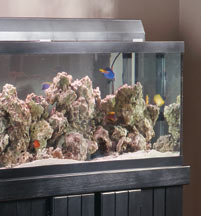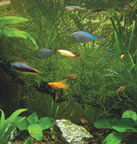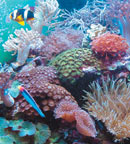Aquarium Lighting: Spectrum and Intensity - Part 2
|
Aquarium lighting not only enhances the appearance of your aquarium, it also helps boost the general health of your fish, plants, and invertebrates. When designing a lighting system for your aquarium, you should try to duplicate - as closely as possible - the conditions in which your aquarium pets would live naturally. Thankfully, technological advancements in aquarium lighting over the past decade have significantly simplified the task of simulating natural conditions.
Part one of this article described the characteristics of light. This portion of the article will discuss the duplication of natural light in fish-only, freshwater planted, and saltwater reef aquariums.
When selecting your fish-only aquarium lighting system, take into account not only the initial cost, but also the operating cost. Choose a lighting fixture that does not require excessive amounts of electricity or frequent bulb changes. When shopping for lamps for your fish-only aquarium, choose a bulb rated at two watts per gallon of water in your aquarium (for example, choose a 60-watt bulb for a 30-gallon aquarium). Due to their relatively low initial cost and operating costs, standard fluorescent systems or power compact fluorescent systems work well for fish-only aquariums. Once you've selected your lighting system, you can choose a bulb with a spectrum based on your personal preference. A lamp with a low Kelvin (K) rating (towards the redder end of the spectrum) will exhibit more vivid colors than a lamp with a higher Kelvin rating (and a bluer color). However, lamps with a low K rating tend to promote algae growth, resulting in more aquarium maintenance. If your goal is to illuminate your aquarium with a color-enhancing bulb, you can avoid excessive algae growth either by using a liquid algae destroyer, or by decreasing the daily number of hours during which the light is on.
Most of today's freshwater aquatic plants originated in the shallow tributaries and rivers of Central and South America, where the natural water clarity was typically murky to stained. Because these plants are naturally accustomed to living in dirty shallow water in bright sunlight, you should provide a full spectrum range of light (5500 K to 7500 K) to simulate natural daylight. However, due to varied water qualities in their natural habitats, the light intensity required for freshwater plants will also vary. Between 2 and 5 watts per gallon should be adequate. The initial and operating costs for lighting systems on freshwater plant aquariums depend on the type of system you select, as well as the type of ballast you use with your system. Keep in mind that an initially pricey system may save you money in the long run by using less electricity and requiring less frequent bulb changes. Also, when considering a lighting system for your freshwater plant aquarium, make sure that bulbs are available for that system in the proper spectrum range. Some lighting systems do not offer the full-spectrum bulbs ideal for freshwater planted aquariums. Power compact fluorescent and metal halide lighting systems with carefully selected bulbs work well for freshwater planted aquariums. Further, lighting systems appropriate for a freshwater planted aquarium usually give off large amounts of heat. This must be addressed during system installation. You'll most likely need to incorporate one or more cooling fans and possibly a water chiller to maintain proper water temperature in your aquarium. Room temperature can also have an effect on aquarium temperature, and must also be addressed during aquarium setup - be sure to place your aquarium in a room that does not experience temperature extremes (hot or cold), and a room that will not become excessively warm from the heat given off by the lighting system.
Most corals for the aquarium hobby live naturally in areas surrounding a reef at a depth of 15 to 65 feet. In the wild, these corals typically receive light with a high Kelvin rating (blue in color). Consider initial and operating costs; lighting intensity and spectrum; and the system's radiant heat when choosing a lighting system for your saltwater reef aquarium. Lighting systems for reef aquariums, such as metal halide and HQI systems, tend to be rather expensive due to their high initial cost, high levels of required energy, and characteristically frequent bulb changes. To adequately illuminate reef aquariums 24" deep, plan on providing between 4 and 6 watts of light per gallon of water. Shallow reef aquariums (less than 16" deep), and reef aquariums specifically designed for low-light or non-photosynthetic corals and invertebrates do not require the intensities of taller aquariums. However, under no circumstances should you provide photosynthetic corals and invertebrates with less than two watts of light per gallon of water; they will not have enough light to survive. Natural conditions have caused all corals and invertebrates to adapt to bluer light. Therefore, most lighting systems include bulbs that focus specifically on blue wavelengths. Fluorescent systems, for example, offer blue bulbs called actinic bulbs. While most corals and invertebrates thrive under blue light, most people find blue-lit reef aquariums rather unattractive. This aesthetic dilemma can be solved by combining an actinic light with a white light. Most reef aquariums thrive under a half-and-half blue/white light combination in which the white lights give light in the range of 8000 to 12000 K. This lighting combination gives corals and invertebrates the spectrum necessary for growth, in addition to the spectrum necessary for accurate color rendering within the aquarium. Lighting systems designed for reef aquariums produce two types of intense heat, which must be addressed prior to installation. The first type of heat - from the actual bulbs - surrounds the bulbs and should be removed with cooling fans. The second type of heat - radiant heat produced by the lighting system - is unavoidably absorbed by the aquarium water and should be controlled with a water chiller (be sure to budget for a water chiller in your installation plans). Consider the types of corals and invertebrates you wish to keep before you choose a lighting system for your saltwater reef aquarium. Once you have selected your new pets, look for a lighting system that can effectively simulate the intensity and spectrum of light they receive naturally. You will also need to consider initial and operating costs, and the heat generated by the lighting system.
Conclusion |
|
|







